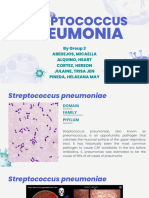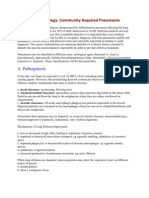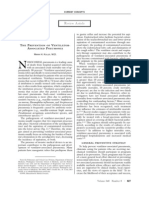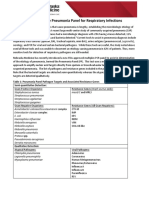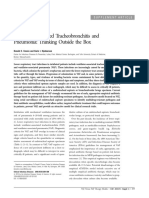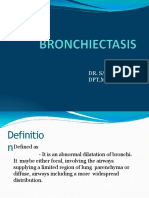72 Ventilator Associated Pneumonia PDF
72 Ventilator Associated Pneumonia PDF
Uploaded by
V RakeshreddyCopyright:
Available Formats
72 Ventilator Associated Pneumonia PDF
72 Ventilator Associated Pneumonia PDF
Uploaded by
V RakeshreddyOriginal Title
Copyright
Available Formats
Share this document
Did you find this document useful?
Is this content inappropriate?
Copyright:
Available Formats
72 Ventilator Associated Pneumonia PDF
72 Ventilator Associated Pneumonia PDF
Uploaded by
V RakeshreddyCopyright:
Available Formats
Ventilator - Associated Pneumonia (VAP)
BR Bansode
INTRODUCTION
VAP is subtype of hospital acquired pneumonia which 5 days. But it is very high i.e. 70% in pts who ventilated for
occur in people who are on mechanical ventilator, through 30 days. Once pts is off the ventilator & transfer to ward/
endotracheal tube (ET) or tracheotomy tube for at least home the incidence of VAP drops significantly in the absence
48 hrs. VAP is medical condition that result from infection of other risk factors for pneumonia.
which floods the alveoli - small, air-filled sacs in the lung
responsible absorbing oxygen from atmosphere. ETIOLOGY OF VAP
MDR non MDR pathogens are potential agent causing VAP.
VAP is distinguished from other type of pneumonia (HAP, Non MDR pathogens are identical to pathogen found in
CAP) by different types of microorganism (MDR, non MDR) severe CAP. The VAP develop in first 5-7 days of mechanical
responsible, use of antibiotics, methods of diagnosis, ventilation.
ultimate prognosis & effective preventive measures.
In patients having other risk factors for HCAP, MDR pathogen
EPIDEMIOLOGY may vary from hospital to hospital & different critical care
VAP is common complication amongst patients who require unit in same institution. Many hospital have problem with
mechanical ventilations. Prevalence is 6-52 cases per 100 pts P. aeruginosa & MRSA. Viral & fungal infection causing VAP
on any given day in ICU an average of 10% of pts will have is less common, but in immunocompramised pts VAP can
VAP. The frequency of diagnosis is not static but changes cause by these organism. (Table I).
with duration of mechanical ventilation, but highest in first
Table I. Microbiologic Causes of Ventilator- Associated Pneumonia
Non - MDR Pathogens MDR Pathogens
Streptococcus pneumoniae Pseudomonas aeruginosa
Other streptococcus SPP. MRSA
Haemophilius influenzae Acinetobacter SPP.
MSSA Antibiotic- resistant Enterobacteriaceae
Antibiotic - sensitive Enterobacteriaceae Enterobacter SPP.
Escherichia Coli ESBL - positive strains
Klebsiella pneumoniae Klebsiella SPP.
Proteus SPP. Legionella pneumophila
Enterobacter SPP. Burkholderia cepacia
Serratia marcescens Aspergilius SPP
ESBL, extended -spectrum β lacttamase; MDR, mutidrug - resistant;
MRSA, methicillin - resistant Staphylococcus aureus; MSSA, methicillin -sensitive S. Aureus.
416 Medicine Update-2011
Pathology respiratory tract.
The three factors are critical in pathogenesis of VAP 3. Compromise of the normal host defense mechanism.
1. Colonization of the oropharynx with pathogenic (Table II)
microorganism, The most obvious risk factor is ET, which by pass the
2. Aspiration of these pathogen from oropharynx into lower normal mechanical factors preventing aspirations. But
Table II. Pathogenic mechanisms and corresponding prevention strategies for ventilator associated pneumonia
Pathogenic Mechanism Prevention strategy
Oropharyngeal colonization with
pathogenic bacteria
Elimination of normal flora Avoidance of prolonged
antibiotic courses
Large-volume oropharyngeal Short course of prophylactic
aspiration around time antibiotics for comatose patients
of intubation
Gastroesophageal reflux Postpyloric enteral feeding,
avoidance of high gastric residuals,
prokinetic agents
Bacterial overgrowth of stomach Avoidance of gastrointestinal bleeding
due to prophylactic agents that raise gastric PH,
selective decontamination of digestive tract with
nonabsorbable antibiotics
Cross-infection from other Hand washing, especially with alcohol-
colonized patients based hand rub; intensive infection control
education; isolation; proper cleaning of
reusable equipment
Large -volume aspiration Endotracheal intubation; avoidance of
sedation; decompression of small-bowel
obstruction
Microaspiration around
endotracheal tube
Endotracheal intubation Noninvasive ventilation
Prolonged duration of Daily awakening from sedation
ventilation weaning protocols
Abnormal swallowing function Early percutaneous tracheostomy
Secretions pooled above Head of bed elevated; continuous
endotracheal tube aspiration of subglottic secretions
with specialized endotracheal
tube; avoidance of reintubation;
minimization of sedation and patient transport
Altered lower respiratory host defenses Tight glycemic control; lowering of
hemoglobin transfusion threshold; specialized
enteral feeding formula
Medicine Update-2011 417
microaspiration can reach lower respiratory tract. ET & tract require 103 cfu/ml the sample from lower resp. tract
suctioning can damage the tracheal mucosa, facilitating should be collected properly by bronchoscopy or BAL to
tracheal colonization. Pathogenic bacteria can form a increase sensitivity. The IDSA & ATS guideline have suggested
glycocalyx biofilin on ET surface that protect them from that all these methods are appropriate & choice depends
antibiotic & host defenses. These pathogen can dislodged on availability & local expertise. High diagnostic threshold
during suctioning & small fragement of glucolyx can embolise can be obtained if sample taken before starting of antibiotic
to lower respiratory tract carrying bacteria with them. therapy or changed the antibiotic.
In critically ill pts normal oropharyngeal flora replaced by The clinical approach (CPIS) improve the diagnostic criteria.
pathogenic microorganism, cross infection from other pts The clinical pulmonary infection score was developed
or paramedicals, contaminated equipment & malnutrition considering various clinical criteria. The CPIS can help to
contribute to development of VAP. Severely ill pts with sepsis decide the choice antibiotic requirement, MDR coverage to
& trauma enter a state of immunoparalaysis several days be given or not and outcome of VAP affected individuals.
after admission in ICU are greater risk of developing VAP. (Table III).
Hyperglycemia affect neutrophil function & many recent
trial have shown that keeping blood sugar close to normal Transport of bacteria from sinus, stomach or blood stream
with exogenous insulin have beneficial effects like decrease is rare.
risk of infection. The frequent blood transfusion (leukocyte
depleted) also affect the immune response in individual pts. CLINICAL MANIFESTATION
The clinical manifestation of VAP in pts who are on
The quantitative culture approach is to discriminate between mechanical ventilation are often sedated & are unable to
colonization and true infection. The sampling from lower communicate. Many typical presentation of pneumonia
respiratory tract exclude the colonization & require lower will be either absent or unable to be obtained. The most
threshold of growth necessary to diagnose pneumonia. For important S/S are fever or low body temperature new
example samples endotracheal aspirate require diagnostic purulent sputum, hypoxia, leukocytosis, appearance of
threshold is 106 cfu/ml the sample from lower respiratory new infiltrate on x-ray chest or consolidation, other signs
like tachypnea, tachycardia, increase minute ventilation.
Table III. Clinical Pulmonary Infection Score (CPIS)
DIAGNOSIS
VAP should be suspected in any patients on mechanical
ventilation exhibiting increasing leukocyte count, new
shadows (infiltrate) on chest x-ray as is indicative of
pneumonia. Blood culture may reveal the microorganism
causing VAP. The strategic approach i.e. collect culture from
trachea/ET & new or enlarging infiltrate on x-ray chest. The
other is invasive i.e. bronchoscopy plus bronchoalveloar
lavage for pts with evidence of VAP. When both these
methods yield negative culture the diagnosis of VAP is
unlikely.
The differential diagnosis of VAP is a typical pulmonary
edema, pulmonary contusion/hemorrhage, hypersensitivity
pneumonia, ARDS & pulmonary embolism. Clinical finding
inventilated patient with fever & leukocytosis may have
different diagnosis than VAP, like antibiotic associated
@ The progression of the infiltrate is not known and tracheal diarrhea, sinusitis, UTI, pancreatitis, drug fever, which
aspirate culture results are often unavailable at the time of require antibiotic from different group than VAP, surgical
the original diagnosis; thus, the maximal score is initially 8-10
Note: ARDS, acute respiratory distress syndrome; CHF, drainage, or catheter removal for optimal management.
congestive heart failure
418 Medicine Update-2011
MANAGEMENT OF VAP Once etiologic diagnosis is made the antibiotic therapy may
Management of VAP should be matched to known causative be with single drug in 50% cases, while in 25% pts require
bacteria. When first time VAP is suspected bacteria causing two drug combination, like ? lactum & aminoglycosides.
infection is typically not known then broad spectrum VAP causes by MRSA is associated with 40% clinical failure,
antibiotic (Empiric therapy) are given until particular Linezolid is more efficacious than standard dose of
bacterial culture and sensitivity determined. Empiric vancomycin in pts with renal insufficiency.
therapy should be started taking into both risk factors
particular resistance bacteria as well as local prevalence of FAILURE TO IMPROVE
resistance microorganism. So management entirely depends Treatment failure is more common in VAP caused by MDR
on knowledge of local flora which vary from hospital to pathogen. 40% failure when VAP (MRSA) treated with
hospital. (Table IV). vancomycin & 50% failure in VAP caused by P.aeruginosa by
any antibiotics.
If MDR pathogen not suspected the VAP should be
treated with antibiotic used for severe CAP. However MDR Recurrent VAP caused by same pathogen is possible because
pathogen isolated like drug resistance MRS & ESBL positive of biofilim on ET allows reintroduction of microorganism. VAP
Enterobacteriaceae or intrinsically resistant pathogen P due to new super infection and pressure of extra pulmonary
aeruginosa & acinetobacter, the β lactum drug specially infection & drug toxicity must be consider in the differential
cephalosporin should be given. P aeruginosa develop diagnosis of treatment failure.
resistance to all routinely used antibiotics. Acinctobacter,
stenotrophomanas maltophillia & Burkholderia cepacia are COMPLICATIONS
intrinsically resistance to many empiric antibiotic regimens Apart from death, the major complication of VAP is
or during therapy of VAP. prolongation of mechanical ventilation & stay in ICU. Some
time necrotizing pneumonia & pulmonary hemorrhage occur
Most pts without risk factor for MDR infection should due to pseudomonas aeruginosa. Bronchiectasis & pulmonary
be treated with single agent. Legionella which can be scarring leading to recurrent pneumonias, catabolic state in
nosocomial microorganism in VAP, where potable water pts who is malnourished. Elderly pts more crippled & need
deficiency in the hospital. lifelong nursing care.
Table IV. Empirical Antibiotic Treatment of Health Care - Associated Pneumonia
Patients without Risk factors for MDR Pathogens
Cefriaxone (2g IV q24h) or
Moxifloxacin (400mg IV q24h), Ciprofloxacin (400mg IV q8h), or Levofloxacon
(750mg IV q24h) or
Ampicillin/ sulbactam (3g IV q6h) or
Ertapenem (1g IV q24h)
Patients with Risk Factors for MDR Pathogens
1. A β- lactam
Ceftazidime (2g IV q8h) or Cefepime (2g IV q8 - 12h) or
Piperacillin/tazobactam (4.5 g IV q6h), imipenem (500mg IV q6h or 1 g IV q8h), or meropnem (1g IV q8h) plus
2. A second agent active against gram - negative bacterial pathogens:
Gentamycin or tobramycin (7 mg/kg IV q24h) or amikacin (20mg/kg IV q24h) or
Ciprofloxacin (400mg IV q8h) or levofloxacin (750 mg IV q24h) plus
3. An agent active against gram - positive bacterial pathogens:
Linezolid (600mg IV q12h) or
Vancomycin (15mg/kg, up to 1 g IV, q12h)
MDR, multidrug-resistant
Medicine Update-2011 419
The clinical improvement if it occur is evident in first 48 to72 nasal or face mask can avoid ET associated risk factors.
hrs of initiation of antibiotic therapy. Hypoxia disappear but Early extubation, avoiding heavy sedation, proper aseptic
clinical infiltrate initially worsen during the treatment, the precaution for suction procedure, use of mouth wash can
clinical criteria are good indicator of response to therapy in reduced incidence of VAP.
VAP. Once pts is improved stable follow up with x-ray chest Reintubation, transport pts for different procedure have
may not be necessary for few weeks. higher incidence of VAP. Recently use of silver coating
ET may also reduce incidence of VAP.
PROGNOSIS Elevating head end 30-45° above horizontal significantly
VAP is associated with 50-70% mortality. Pts who develop VAP reduce VAP rate.
are at least twice risk of death than who do not develop. MRSA & the nonfermenters P.aeruginosa & Acinetobacter
SPP are normally not part of bowel flora but resides
VAP in trauma pts mortality is less. VAP caused by MDR primarily in the nose & on the skin respectively. So
pathogen has significant mortality than non MDR pathogen. controlling overgrowth of bowel flora & proper cleaning
VAP caused by S.Maltophilia is a marker for pts who is of nose & skin can reduce VAP rate.
immunocompramised that death is inevitable. Consistant infection control practice in hospital/ICU can
minimize VAP rate.
PREVENTION
At early stages of illness use of noninvasive ventilation via
REFERENCES
1. American thoracic society / infectious diseases society of America 6. Bergstrom, C. T., M. Lo, and M. Lipsitch. 2004. Ecological theory
: guidelines for the management of adults with hospital - acquired, suggests that antimicrobial cycling will not reduce antimicrobial
ventilator - associated, and healthcare-associated pneumonia. Am resistance in hospitals. Proc. Natl. Acad. Sci. USA 101:13285-13290.
J respire crit care Med 171 : 388, 2005. 7. Campbell, G. D., Jr. 2000. Blinded invasive diagnostic procedures in
2. Chastre J, Fagon JY ; ventilator-associated pneumonia. Am J Respir ventilator-associated pneumonia. Chest 117:207S-211S.
Crit Care med 165 : 867, 2002. 8. Carlucci, A., J. C. Richard, M. Wysocki, E. Lepage, and L. Brochard.
3. Lim WS et al: defining community acquired pneumonia severity on 2001. Noninvasive versus conventional mechanical ventilation. An
presentation to hospital : An international derivation and validation epidemiologic survey. Am. J. Respir. Crit. Care Med. 163:874-880.
study. Thorax 58 : 377, 2003 9. Chastre, J. 2005. Conference summary: ventilator-associated
4. Mandell LA et al: Infectious Diseases society of America / American pneumonia. Respir. Care 50:975-983.
Thoracic society consensus guidelines on the management of 10. Cook, D., and L. Mandell. 2000. Endotracheal aspiration in the
community - acquired pneumonia. Clin Infect dis 44 (suppl 2) : s27, diagnosis of ventilator-associated pneumonia. Chest 117:195S-197S.
2007 11. Fartoukh, M., B. Maitre, S. Honore, C. Cerf, J. R. Zahar, and C. Brun-
5. Azoulay, E., J. F. Timsit, M. Tafflet, A. de Lassence, M. Darmon, J. R. Buisson. 2003. Diagnosing pneumonia during mechanical ventilation:
Zahar, C. Adrie, M. Garrouste-Orgeas, Y. Cohen, B. Mourvillier, and B. the clinical pulmonary infection score revisited. Am. J. Respir. Crit.
Schlemmer. 2006. Candida colonization of the respiratory tract and Care Med. 168:173-179.
subsequent Pseudomonas ventilator-associated pneumonia. Chest 12. Kollef, M. H. 2005. What is ventilator-associated pneumonia and
129:110-117. why is it important? Respir. Care 50:714-724.
You might also like
- 2019FS026 Communicate With FusionSolar Through An openAPI AccountDocument13 pages2019FS026 Communicate With FusionSolar Through An openAPI Accountwbwfalwcbggsr logicstreakNo ratings yet
- FS Episode 8Document18 pagesFS Episode 8Abegail Linaga93% (104)
- 1ST Term J1 Home EconomicsDocument22 pages1ST Term J1 Home EconomicsPeter Omovigho Dugbo100% (2)
- MICROMIDTERMSLABDocument27 pagesMICROMIDTERMSLABmicaellaabedejosNo ratings yet
- Ijrms VapDocument7 pagesIjrms VapShaik UsmanNo ratings yet
- PneumoniaDocument79 pagesPneumoniaEjiro OnoroNo ratings yet
- VAP in ICU ReviewDocument8 pagesVAP in ICU ReviewAdam KurniaNo ratings yet
- 202 Antibiotics in Critical Care 3 - Critical Care-Associated InfectionsDocument9 pages202 Antibiotics in Critical Care 3 - Critical Care-Associated InfectionsCristina TrofimovNo ratings yet
- Ventilator Associated Pneumonia (Vap)Document11 pagesVentilator Associated Pneumonia (Vap)Suresh KumarNo ratings yet
- 118 ReviewerDocument6 pages118 ReviewerAna Rose Dela CruzNo ratings yet
- PneumoniaDocument42 pagesPneumoniaPRABHAT KUMARNo ratings yet
- Hospital Acquired PneumoniaDocument36 pagesHospital Acquired Pneumoniaadamu mohammadNo ratings yet
- PneumoniaDocument8 pagesPneumoniaCostescu ClaudiaNo ratings yet
- VAP Risk Factors and PreventionDocument8 pagesVAP Risk Factors and PreventionFrancis CastanedaNo ratings yet
- Basic Concepts On Communityacquired Bacterial Pneumonia in PediatricsDocument6 pagesBasic Concepts On Communityacquired Bacterial Pneumonia in PediatricsJesselle LasernaNo ratings yet
- Vapdr 160402054803Document98 pagesVapdr 160402054803Vignesh VNo ratings yet
- Ventilator-Associated Pneumonia AddDocument12 pagesVentilator-Associated Pneumonia AddKristin BienvenuNo ratings yet
- 15 Pneumonia HandoutsDocument44 pages15 Pneumonia HandoutsTimothy YakubNo ratings yet
- Hospital Acquired PneumoniaDocument48 pagesHospital Acquired PneumoniaKartika RezkyNo ratings yet
- Pcap Didactics ChanDocument61 pagesPcap Didactics ChanValerie Anne BebitaNo ratings yet
- Nosocomial Pneumonia: Self AssessmentDocument10 pagesNosocomial Pneumonia: Self AssessmentZali AhmadNo ratings yet
- Research: Sensitivity of Embryos Related To The Pneumonia Associated With The Ventilation MechanicsDocument10 pagesResearch: Sensitivity of Embryos Related To The Pneumonia Associated With The Ventilation Mechanicscarmen.warthon13No ratings yet
- Ijcrr VapDocument8 pagesIjcrr VapShaik UsmanNo ratings yet
- Microbial Diseases of The Respiratory System: Pertussis (Whooping Cough) PathogenesisDocument15 pagesMicrobial Diseases of The Respiratory System: Pertussis (Whooping Cough) PathogenesisCharlene SibugNo ratings yet
- Ventilator Associated PneumoniaDocument15 pagesVentilator Associated PneumoniaErlina RatmayantiNo ratings yet
- L23 - Pneumonia MedDocument51 pagesL23 - Pneumonia MedAL-ashai MohammedNo ratings yet
- 12 Mei 2019 JR 1 EUROPEAN JOURNAL VAPDocument25 pages12 Mei 2019 JR 1 EUROPEAN JOURNAL VAPMessakh DessieNo ratings yet
- Pneumonia Historical ClassificationDocument24 pagesPneumonia Historical ClassificationVenkat Arjun GandiNo ratings yet
- Ventilator-Associated Pneumonia - Risk Factors & Prevention (Beth Augustyn)Document8 pagesVentilator-Associated Pneumonia - Risk Factors & Prevention (Beth Augustyn)ariepitonoNo ratings yet
- Cap MRDocument4 pagesCap MRKit BarcelonaNo ratings yet
- Current Concepts: T P V - A PDocument8 pagesCurrent Concepts: T P V - A PrachmiaNo ratings yet
- Lung Abscess: DR Budi Enoch SPPDDocument14 pagesLung Abscess: DR Budi Enoch SPPDLia pramitaNo ratings yet
- Pneumonia Panel GuidelineDocument8 pagesPneumonia Panel Guidelineilham perdiansyahNo ratings yet
- Suaya 2020Document40 pagesSuaya 2020Tamara WindaNo ratings yet
- Clinical PresentationDocument54 pagesClinical PresentationSêrâphîm HâdíNo ratings yet
- Nosocomial Pneumonia Nosocomial PneumoniaDocument37 pagesNosocomial Pneumonia Nosocomial PneumoniaAjay AgrawalNo ratings yet
- Community Acquired PneumoniaDocument52 pagesCommunity Acquired Pneumoniatummalapalli venkateswara rao100% (6)
- Pneumonia: Anjitha JosephDocument43 pagesPneumonia: Anjitha JosephanjithaNo ratings yet
- Updated: Dec 07, 2016 Author: Justina Gamache, MD Chief Editor: Guy W Soo Hoo, MD, MPHDocument42 pagesUpdated: Dec 07, 2016 Author: Justina Gamache, MD Chief Editor: Guy W Soo Hoo, MD, MPHgita suci arianiNo ratings yet
- Practice Essentials: Essential Update: Telavancin Approved For Bacterial PneumoniaDocument12 pagesPractice Essentials: Essential Update: Telavancin Approved For Bacterial PneumoniaAnnette CraigNo ratings yet
- Ventilator-Associated Tracheobronchitis and Pneumonia: Thinking Outside The BoxDocument8 pagesVentilator-Associated Tracheobronchitis and Pneumonia: Thinking Outside The BoxRoberto Linhares de FreitasNo ratings yet
- Dr. Sana Bashir DPT, MS-CPPTDocument46 pagesDr. Sana Bashir DPT, MS-CPPTbkdfiesefll100% (1)
- HapDocument15 pagesHapWinariieeyy Nayy100% (1)
- Healthcare Associated Pneumonia - Dr. Christian A. Johannes, SP - an.KICDocument30 pagesHealthcare Associated Pneumonia - Dr. Christian A. Johannes, SP - an.KICvenyNo ratings yet
- 30794136: Aspiration Pneumonia in Older AdultsDocument7 pages30794136: Aspiration Pneumonia in Older AdultsNilson Morales CordobaNo ratings yet
- Bacterial Pneumonia in Cattle - Respiratory System - Veterinary ManualDocument4 pagesBacterial Pneumonia in Cattle - Respiratory System - Veterinary ManualMutiara DarisNo ratings yet
- Lecture 7 - Nosocomial PneumoniaDocument30 pagesLecture 7 - Nosocomial PneumoniaKartika Rezky100% (2)
- Pneumonia in ChildrenDocument22 pagesPneumonia in ChildrenHarsha HinklesNo ratings yet
- 2005 RCDocument16 pages2005 RCNoelia CalderónNo ratings yet
- Pediatric Community-Acquired Pneumonia: Nelson 20 EdDocument43 pagesPediatric Community-Acquired Pneumonia: Nelson 20 EdRazel Kinette AzotesNo ratings yet
- Jurnal Bahasa InggrisDocument12 pagesJurnal Bahasa InggrisVanessa Angelica SitepuNo ratings yet
- Lung AbscessDocument7 pagesLung AbscessItha Maghfirah100% (1)
- PneumoniaDocument38 pagesPneumoniaAzhar GhoriNo ratings yet
- Pneumonia With Pleural EffusionDocument24 pagesPneumonia With Pleural EffusionMund CheleNo ratings yet
- Hunter - VAP - Postgrad Med J-2006 (Bakteri Penyebab VAP Terbanyak)Document8 pagesHunter - VAP - Postgrad Med J-2006 (Bakteri Penyebab VAP Terbanyak)Irfany Nurul HamidNo ratings yet
- Oxygen Saturation (If Available) : IagnosisDocument3 pagesOxygen Saturation (If Available) : Iagnosisrezairfan221No ratings yet
- Management of Pneumonia Syndromes in The HospitalDocument13 pagesManagement of Pneumonia Syndromes in The HospitalKelly Enedina NunesNo ratings yet
- Ventilator Associated Pneumonia TreatmentDocument43 pagesVentilator Associated Pneumonia Treatmentmkc71No ratings yet
- Review: Atypical Pathogen Infection in Community-Acquired PneumoniaDocument7 pagesReview: Atypical Pathogen Infection in Community-Acquired PneumoniaDebi SusantiNo ratings yet
- Aspergillus in BronsioectaziiDocument15 pagesAspergillus in BronsioectaziiCristinaLucanNo ratings yet
- Comprehensive Insights into Haemophilus Influenzae: From Biology to Global Health StrategiesFrom EverandComprehensive Insights into Haemophilus Influenzae: From Biology to Global Health StrategiesNo ratings yet
- Meningococcal Infection: Pathogenesis, Impact, and InterventionsFrom EverandMeningococcal Infection: Pathogenesis, Impact, and InterventionsNo ratings yet
- Beginners Piano Book PDFDocument50 pagesBeginners Piano Book PDFV RakeshreddyNo ratings yet
- ECGchanges in Patients With Acute StrokeDocument6 pagesECGchanges in Patients With Acute StrokeV RakeshreddyNo ratings yet
- Acute Kidney InjuryDocument18 pagesAcute Kidney InjuryV RakeshreddyNo ratings yet
- 10 1097@NRL 0b013e31817533a3 PDFDocument10 pages10 1097@NRL 0b013e31817533a3 PDFV RakeshreddyNo ratings yet
- Study of Haematological Parameters in Malaria: Original Research ArticleDocument6 pagesStudy of Haematological Parameters in Malaria: Original Research ArticleV RakeshreddyNo ratings yet
- Opfinalppt 160117042516 PDFDocument83 pagesOpfinalppt 160117042516 PDFV RakeshreddyNo ratings yet
- Deposito Diessel-Newberry - Data Sheet - Drawing - Single Fuel Tank PDFDocument4 pagesDeposito Diessel-Newberry - Data Sheet - Drawing - Single Fuel Tank PDFRolan PonceNo ratings yet
- Lifting Appliances Guide Jun20Document244 pagesLifting Appliances Guide Jun20cnl filesNo ratings yet
- Book Review: Screw It, Let's Do It - Lessons in LifeDocument8 pagesBook Review: Screw It, Let's Do It - Lessons in LifeAmish MehtaNo ratings yet
- Focus Fault ListDocument1 pageFocus Fault ListJESUS LURITANo ratings yet
- Wa0001.Document3 pagesWa0001.Kavita KapseNo ratings yet
- Bob Proctor - Mind and Money StrategiesDocument9 pagesBob Proctor - Mind and Money StrategiesHadi Marsudianto67% (3)
- Integrated Humanities Notes: SuperpowersDocument15 pagesIntegrated Humanities Notes: SuperpowersAimal RashidNo ratings yet
- Mis 21 1,2,3Document34 pagesMis 21 1,2,3Arbaz ShahNo ratings yet
- ASPEN Tutorial - Chemical ReactorsDocument4 pagesASPEN Tutorial - Chemical ReactorsShah MhNo ratings yet
- Code of Ethics: Bustamante, Guianne Carlo B. CE195 - C2 CE-4 / 2010100616 April 26, 2014 Engr. Geoffrey CuetoDocument4 pagesCode of Ethics: Bustamante, Guianne Carlo B. CE195 - C2 CE-4 / 2010100616 April 26, 2014 Engr. Geoffrey CuetoGuianne Carlo BustamanteNo ratings yet
- Psicoeducazione 2 PDFDocument16 pagesPsicoeducazione 2 PDFFlavia CaturanoNo ratings yet
- ResumeDocument5 pagesResumeShyam Ramanath ThillainathanNo ratings yet
- JRIZAL030 ConceptPaperFinalDocument2 pagesJRIZAL030 ConceptPaperFinalRoselle Balalitan PortudoNo ratings yet
- Vocabulary Confusing Verbs - English ESL Video LessonDocument1 pageVocabulary Confusing Verbs - English ESL Video LessonSochanvatey HeanhNo ratings yet
- Chap 003Document8 pagesChap 003Anum SayyedNo ratings yet
- User-Centered Approaches To Interaction Design: by Haiying Deng Yan ZhuDocument38 pagesUser-Centered Approaches To Interaction Design: by Haiying Deng Yan ZhuJohn BoyNo ratings yet
- Lipid Metabolism Quize PDFDocument5 pagesLipid Metabolism Quize PDFMadani TawfeeqNo ratings yet
- Anthropometry and Clothing ConstructionDocument9 pagesAnthropometry and Clothing ConstructionAsif MangatNo ratings yet
- Dairy Bull - 551BS01410 - TWinkle-Hill Sblamborghini - TMDocument1 pageDairy Bull - 551BS01410 - TWinkle-Hill Sblamborghini - TMJonasNo ratings yet
- Vector 2 Notes - by TrockersDocument139 pagesVector 2 Notes - by TrockersFerguson UtseyaNo ratings yet
- Room Rates HrasDocument3 pagesRoom Rates HrasRhonna Aromin NavarroNo ratings yet
- Background:: Bangladesh Cement IndustryDocument63 pagesBackground:: Bangladesh Cement Industryyeasmin mituNo ratings yet
- Noli Me TangereDocument4 pagesNoli Me TangereGrace Cañones-TandasNo ratings yet
- Error Amplifier Ics (Se Series)Document1 pageError Amplifier Ics (Se Series)klaus allowsNo ratings yet
- The Business As Usual Behind The Slaughter - Lars SchallDocument17 pagesThe Business As Usual Behind The Slaughter - Lars SchallAlonso Muñoz PérezNo ratings yet
- LP 19 JuneDocument2 pagesLP 19 JuneIlham IzzatNo ratings yet
- Poverty Alleviation Through MicrocreditDocument8 pagesPoverty Alleviation Through MicrocreditLayes AhmedNo ratings yet



